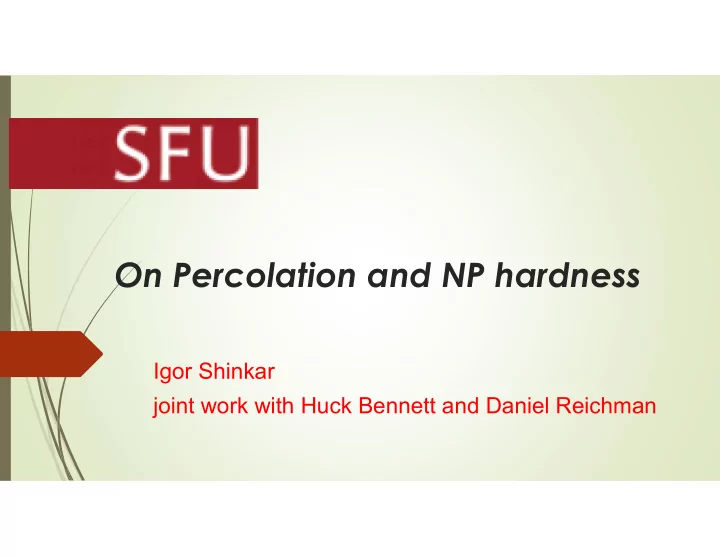

On Percolation and NP hardness Igor Shinkar joint work with Huck Bennett and Daniel Reichman
Coloring Random Subgraphs of a Fixed Graph Igor Shinkar joint work with Huck Bennett and Daniel Reichman
Random graphs is the standard model of random graphs: start with the complete graph 𝐿 � keep each edge with probability 𝑞 . We understand well the standard graph related quantities. For example, for : maximum clique = Θ log (𝑜) maximum independent set = Θ log (𝑜) � Chromatic number = Ω ��� �
Random graphs is the standard model of random graphs: start with the complete graph 𝐿 � keep each edge with probability 𝑞 . What about the algorithmic problems on ? Find maximum clique in 𝐻(𝑜, 0.5) Find the optimal coloring of 𝐻(𝑜, 0.5) We have efficient approximation algorithms, but we don’t know optimal algorithms.
Random subgraphs of a fixed graph For the rest of the talk =0.5. Fix a graph and a parameter . Denote by � a random subgraph of , where each edge is kept with probability . What about the algorithmic problems on 𝑞 ?
Graph coloring Given a graph we want to assign colors to the vertices so that no two adjacent vertices share the same color. The smallest number of colors needed to color a graph is called its chromatic number , .
Graph coloring Theorem: Computing is NP-hard. Theorem: It is NP-hard to tell if or . Question: What about computing � ? Does this problem become easier than the standard worst-case problem?
Graph coloring Theorem: Given an input graph it is NP-hard to compute �.� with high probability. That is, if we can compute �.� with high probability, then we can compute with high probability.
Graph coloring Theorem: Given an input graph 𝐻 = (𝑊, 𝐹) it is NP-hard to compute 𝜓 𝐻 �.� with high probability. Proof: We show a polytime reduction that gets 𝐻 and outputs 𝐻′ s.t. 𝜓 𝐻′ = 𝜓 𝐻 , and with high probability 𝜓 𝐻 �.� = 𝜓 𝐻 . How? Graph blow-up: “make the edges thicker"
What about other NP-hard problems on ?
Some problems become easier What about other NP-hard problems? Are they all NP-hard for � Theorem: Given an input graph we can find the maximum clique in �.� with high probability in time �(��� (�)) . Proof: Max clique in �.� has size at most . Max-Clique is NP-hard, but Max-Clique on � is much easier
Chromatic number of The question of B. Bukh
Random subgraphs of a fixed graph Fix a graph and consider . �.� Q: What can we say about � as a function of ? Q: What can we say about as a function of ? �
Some trivial facts Clearly . � If is a union of many -cliques, then . � If � then � . We know . �
The question [Bukh] Question : Let be a graph with . Prove that . �.�
Some facts Theorem 1 [Easy] : Let be a graph with . Then . �.� �.� . Answers the question for But what if �(�) ? Theorem 2 [Bennet, Reichman, S. 16] : Let be a graph with and 𝛽 𝐻 ≤ 𝑃(𝑜/𝑙) . Then . Holds for most graphs, �.� e.g., Theorem 3 [Mohar, Wu 18] : Let be a graph with � . Then � . �.� �
More facts Theorem [Easy] : Let be a graph with . Then . �.� In fact, . �.� Proof [Easy] : Let �.� . Note that is distributed like �.� . Then . � � �� �\� Hence . �.� �
A more refined question Let be a graph with . And let . Question : What is the probability that ? Is it true that ? �.� Is it true that ? �.� Special case : What is the probability that ? �.� � . Fact : For � we have �.�
Probability that is bipartite Theorem : Let be a graph with for . � . Then �.� Lemma : Suppose that every -coloring of leaves monochromatic edges. I won’t prove it here. Then . �.� As a hint we use the following lemma. Proof of Theorem : If , then in any - coloring of one of the colors induces a subgraph with . � � edges. � � � Fact: contains � � . ▄ Using the lemma we get that �.�
Probability that is bipartite Theorem : Let be a graph with for . � . Then �.� � . This should be compared to Therefore, for all with we have �.�
Probability that is small Theorem : Let be a graph with and let �/� . � ��� � Then . �.� � � � ��� ��� (�) For we have . � In particular, . �/� �.�
Open problems: 1. Prove/disprove: For all with . � � 2. Prove/disprove: For all with and . � 3. Prove/disprove: For all with and . �/� � �
Open problems: 1. Find maximal � such that for all planar for all � � Fact: � ��/� . Is this tight? 2. Find maximal � such that for all planar w.h.p. � � is bipartite. 3. Find maximal ���� such that for all planar w.h.p. � ���� has no cycles. Fact: ���� ��/� . Is this tight?
Recommend
More recommend